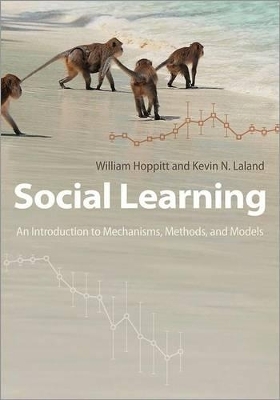
Social Learning
Princeton University Press (Verlag)
978-0-691-15071-0 (ISBN)
* Provides a comprehensive, practical guide to social learning research * Combines theoretical and empirical approaches * Describes techniques for the laboratory and the field * Covers social learning mechanisms and strategies, statistical modeling techniques for field data, mathematical modeling of cultural evolution, and more
William Hoppitt is senior lecturer in zoology at Anglia Ruskin University. Kevin N. Laland is professor of behavioral and evolutionary biology at the University of St. Andrews. His books include Culture Evolves and Niche Construction: The Neglected Process in Evolution
Acknowledgments ix 1Introduction 1 What Is Social Learning? 3 Social transmission 5 Imitation 9 Innovation 9 Why Study Social Learning? 11 Summary of the Book 14 2A Brief History of Social Learning Research 16 The Evolution of Mind 17 Social Learning Mechanisms 20 Animal "Culture" 24 The Diffusion of Innovations 27 Child Development 28 Cultural Evolution 30 Conclusions 31 3Methods for Studying Social Learning in the Laboratory 33 Traditional Social Learning Studies 35 Alternative Experimental Approaches 38 Transmission chain studies 40 Diffusion studies 47 Innovation 50 The Biological Bases of Social Learning 52 Neuroendocrinological studies 53 Social learning of fear 54 Neural mechanisms of observational learning 56 Conclusions 61 4Social Learning Mechanisms 62 A Classification of Social Learning Mechanisms 63 Stimulus enhancement 65 Local enhancement 65 Observational conditioning 68 Response facilitation 69 Social facilitation 70 Imitation 70 Observational R-S learning 77 Emulation 77 Opportunity providing 78 (Inadvertent) coaching 79 Distinguishing Social Learning Mechanisms 80 Stimulus enhancement 80 Local enhancement 81 Observational conditioning 83 Response facilitation 85 Contextual imitation 87 Production imitation 89 Observational R-S learning 92 Emulation 93 Opportunity providing 94 (Inadvertent) coaching 96 A Pragmatic Approach to Characterizing Mechanisms of Social Transmission 96 Teaching 98 Summary 104 5Statistical Methods for Diffusion Data 105 Diffusion Curve Analysis 106 Network-Based Diffusion Analysis (NBDA) 108 Inclusion of individual-level variables 112 Model selection and inference 114 Modeling multiple diffusions 115 Choosing a social network 120 "Untransmitted" social effects 121 Related methods 122 Is NBDA realistic? 123 Examples 125 Spatial Spread of a Behavioral Trait 125 Wave of advance models 125 Other approaches for spatial data 127 Summary 128 6Repertoire-Based Methods for Detecting and Quantifying Social Transmission 129 The Group-Contrasts Approach 130 The Method of Exclusion 133 Basic and advanced methods of exclusion 133 Methods for assessing the genetic hypothesis 134 Methods for assessing the ecological hypothesis 143 Further problems with the method of exclusion 149 A Model-Fitting Approach 150 A matrix regression approach 150 Examples 151 A return to group comparisons 154 A Causal Modeling Framework 155 Relationship to the matrix regression approach 164 Ruling out homophily 164 Ruling out unknown ecological variables 167 Relationship to the method of exclusion 168 Conclusions 168 7Developmental Methods for Studying Social Learning 172 Observational Data 173 Describing the developmental process 173 Modeling probability of acquisition 177 Modeling time of acquisition 179 Modeling proficiency of trait performance 184 Modeling option choice 185 Limitations of observational data 188 Experimental Manipulations 188 Diffusion experiments 189 Manipulation of social experience 191 Translocation studies 193 Conclusions 195 8Social Learning Strategies 196 Why Social Learning Is Strategic 196 "When" Strategies 203 Copy when established behavior is unproductive 203 Copy when asocial learning is costly 205 Copy when uncertain 210 Copy when prior information is outdated 212 Copy when dissatisfied 213 Is copying a first or last resort? 214 "Who" Strategies 215 Frequency-dependent biases 216 Success biases 221 Kin and age biases 225 "What" Strategies 226 Random Copying 227 Statistical Methods for Detecting Social Learning Strategies 229 Meta-strategies, Best Strategies, and Hierarchical Control 232 9Modeling Social Learning and Culture 235 Introduction 235 Why model? 235 Operationalizing the culture concept 237 Parallels between biological and cultural evolution 238 Theoretical Approaches to Social Learning and Cultural Evolution 239 Population-genetic style models of cultural evolution 239 Population-genetic style models of gene-culture coevolution 241 Neutral models and random copying 246 Social foraging theory 250 Spatially explicit models 251 Reaction-diffusion models 253 Agent-based models 254 Phylogenetic models 255 Conclusions 258 10Conclusions 260 References 265 Index 301
| Zusatzinfo | 48 line illus. 2 tables. |
|---|---|
| Verlagsort | New Jersey |
| Sprache | englisch |
| Maße | 178 x 254 mm |
| Gewicht | 680 g |
| Themenwelt | Naturwissenschaften ► Biologie ► Evolution |
| Naturwissenschaften ► Biologie ► Zoologie | |
| ISBN-10 | 0-691-15071-0 / 0691150710 |
| ISBN-13 | 978-0-691-15071-0 / 9780691150710 |
| Zustand | Neuware |
| Haben Sie eine Frage zum Produkt? |
aus dem Bereich


